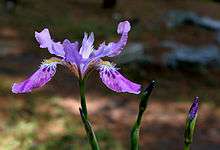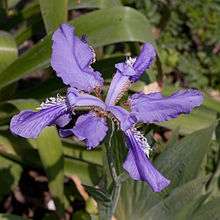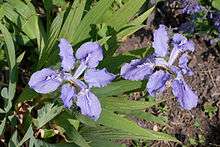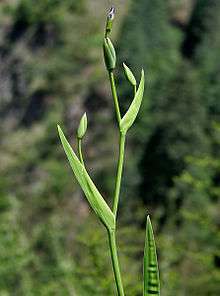Iris milesii
Iris milesii (also known as the red flower iris) is a plant species in the genus Iris, subgenus Limniris and in the section Lophiris (crested irises). It is a rhizomatous, beardless perennial plant, native to the Himalayas, India and China. It has pinkish-violet, or pinkish purple, or pinkish-lavender or pinkish lilac flowers, with a fringed yellow or orange crest (or ridge). It is cultivated as an ornamental plant in temperate regions.
| Iris milesii | |
|---|---|
 | |
| Scientific classification | |
| Kingdom: | Plantae |
| Clade: | Tracheophytes |
| Clade: | Angiosperms |
| Clade: | Monocots |
| Order: | Asparagales |
| Family: | Iridaceae |
| Genus: | Iris |
| Subgenus: | Iris subg. Limniris |
| Section: | Iris sect. Lophiris |
| Species: | I. milesii |
| Binomial name | |
| Iris milesii | |
| Synonyms[1] | |
|
None known | |
Description
It is similar in form to Iris tectorum (another crested iris).[2][3]
It has a short, thick, fleshy, greenish rhizomes,[4][5][6] which are 1–1.5 cm in diameter,[7] they are larger than other crested irises.[8] Underneath the rhizomes, are fleshy roots.[2][9][10] The rhizome is marked on top, with marks or scars of previous seasons leaves.[2][9][10] The rhizome produces lateral (non-flowering) shoots, these later become new growth points for the next season.[2][9][10] During the winter months, it goes dormant, the leaves die, leaving the rhizome bare on the soil surface.[11][12]
It has around 8,[2] basal leaves,[9][10][8] which are slightly glaucous,[2][11][13] yellowish green,[2][14] or greyish green,[7] or pale green.[13][15][16] They are sword-shaped,[7][16] they can grow up to between 30–60 cm (12–24 in) long and 2.5–7 cm (1–3 in) wide.[10][10][17] The leaves are visibly ribbed,[2][18][14] and change in size along the stem.[2][8][13] They die away in the autumn,[3][11] to re-appear in the summer.[17]
It has slender,[12][5] stems that can grow up to between 30–90 cm (12–35 in) tall.[16][19][20] It has 2–4,[2][7] branches,[15][16][19] which are 15–20 cm (6–8 in) long.[7]
Iris milesii and Iris wattii are by far the tallest species of the crested irises group.[21]
The stems have several spathes (leaves of the flower bud), that are 2.5–3.8 cm (1–1 in) long,[7][13] and 2–2.5 cm (1–1 in) wide.[7]
The stems (and the branches) hold between 3 and 4 flowers,[7] in early summer,[4][12] between April to May,[7][11] or May to July.[2][9] They are short lived, but a continuous display can carry on for many weeks,[8][5] 8 to 10 weeks.[11]
The flowers are 6–10 cm (2–4 in) in diameter,[6][13][16] they are smaller than Iris japonica,[12] and Iris tectorum.[3][11] The flowers come in shades of pinkish-violet,[2][9] or pinkish purple,[3][13][22] or pinkish lilac,[4][13][23] pinkish-lavender,[18][16] or pale mauve.[6][19]
It has 2 pairs of petals, 3 large sepals (outer petals), known as the 'falls' and 3 inner, smaller petals (or tepals, known as the 'standards'.[8] The falls are reflexed,[4][23] obovate,[7] 3 cm long,[4] with a blade marked with dark purple, violet or lilac, lines, spots or mottled (streaks or blotches),[16][19][20] it has a finely fringed,[18] or toothed,[4] orange,[7][14][16] or white,[18][8] or yellow crest (or ridge).[5][13][20] The standards are narrowly obovate, 4–5 cm (2–2 in) long.[7][13] They are self-fertile.[2]
It has articulated pedicels, that are 2.5–4 cm (1–2 in) long.[7][13]
It has a small perianth tube, 1–1.5 cm long,[7][13] 2.5 cm long stamen, milky white anthers, 3 cm cylindric ovary.[7]
It has reddish purple, or lilac style branches, which are 3 cm long with deeply fringed (fimbriated) edges.[7][13]
After the iris has flowered, it produces an ovoid-globose,[7] or ovoid-cylindrical seed capsule,[2][9] between June and August.[7]
It is 2.8–3.3 cm (1–1 in) cm long,[9] with veining.[7] Inside the capsule, are pyriform (pear shaped) black brown seeds,[2][7] with a white aril.[7]
Biochemistry

In May 1984, a study was carried out on the rhizomes of Iris milesii, to ascertain their chemical constituency. Several isoflavones (chemical compounds) were found.[11][24]
In December 1884, a further study was carried out on the rhizomes of Iris milesii and Iris kemaonensis (under old spelling 'kumaonensis'). It found several isoflavones in both rhizomes.[25]
Tetra hydroxy-3' methoxyisoflavone (C16H12O7) can be found naturally within the iris,[26] rhizomes.[27]
As most irises are diploid, having two sets of chromosomes, this can be used to identify hybrids and classification of groupings.[8] It has been counted several times, 2n=26, Simonet, 1932 and 2n=26, Chimphamba, 1973.[10] It is normally published as 2n=26.[11][18][20]
Taxonomy
It has the common names of red-flower iris,[9][22][28] and waterbird iris (in Australia).[23][29]
It is written as 红花鸢尾 in Chinese script,[7] and known as hong hua yuan wei in Pidgin in China.[7][28]
The Latin specific epithet milesii refers to Mr Frank Miles, who introduced it into cultivation in about 1880.[3][8][13][15] These plants were grown from seeds collected by his cousin in the Kulu district to the north of Simla.[3][8][13]
It was first published and described by Michael Foster in Gardeners' Chronicle Volume 20 page 231 in 1883.[7][30] John Gilbert Baker also described the iris in Curtis's Botanical Magazine Volume 112, tab.6889 in 1886.[13][28]
It was verified by United States Department of Agriculture and the Agricultural Research Service on 9 January 2003 and then updated on 1 December 2004.[28]
Distribution and habitat

Iris milesii is native to temperate and tropical regions of Asia,[21][29][30]
Conservation
They are 'abundant' in the wild.[18]
Cultivation

Iris milesii is very hardy,[5][13][15] to between USDA Zone 3 and Zone 8,[22] or Zone 10.[29] It is not hardy in the North Carolina climate, because it does not survive the winter.[21] It is hardy in UK,[3][14] to −15 °C (or lower for short periods).[17] It is also hardy,[11] to Europe Zone H3,[4] although it still needs a sheltered position.[13]
It is tolerant of normal garden soil,[3] but prefers well drained,[11][5] sandy, peaty soils.[17][5] It does not like lime.[12] It is tolerant of soils that are mildly acidic or mildly alkaline.[22]
It prefers a sunny[17][15][22] or semi-shade position.[5][6][29]
It also has average water needs.[11][22] It prefers to have moisture during the growing season, but it will not survive in waterlogged sites/[18]
It can be grown in mixed flower border,[11][14][6] or rock gardens.[11]
It does suffer virus problems that Iris tectorum.[11]
Toxicity
Like many other irises, most parts of the plant are poisonous (rhizome and leaves), if mistakenly ingested can cause stomach pains and vomiting. Also handling the plant may cause a skin irritation or an allergic reaction.[22]
References
- "Iris milesii Baker ex Foster is an accepted name". theplantlist.org (The Plant List). 23 March 2013. Retrieved 28 March 2015.
- British Iris Society (1997) A Guide to Species Irises: Their Identification and Cultivation, p. 116, at Google Books
- Dykes, William (2009). "Handbook of Garden Irises" (PDF). beardlessiris.org (The Group for Beardless Irises). Retrieved 1 November 2014.
- James Cullen, Sabina G. Knees, H. Suzanne Cubey (Editors) The European Garden Flora Flowering Plants: A Manual for the Identification (2011) , p. 258, at Google Books
- "Iris milesii". rareplants.co.uk. Archived from the original on 17 April 2015. Retrieved 28 March 2015.
- Stebbings, Geoff (1997). The Gardener's Guide to Growing Irises. Newton Abbot: David and Charles. p. 76. ISBN 0715305395.
- "FOC Vol. 24 Page 308". efloras.org (Flora of China). Retrieved 28 March 2015.
- Austin, Claire (2005). Irises; A Garden Encyclopedia. Timber Press. ISBN 0881927309.
- Ahmad, Shaista. "Red Flower Iris". flowersofindia.net. Retrieved 15 April 2015.
- Walker, Kenneth (13 February 2015). "(SPEC) Iris milesii Foster". wiki.irises.org (American Iris Society). Retrieved 23 March 2015.
- "Chapter II iris clump and other (part3)". irisbotanique.over-blog.com. Retrieved 17 March 2015.
- "Evansia Or Crested Irises". herbs2000.com. Retrieved 18 March 2015.
- Richard Lynch The Book of the Iris, p. 90-91, at Google Books
- Cassidy, George E.; Linnegar, Sidney (1987). Growing Irises (Revised ed.). Bromley: Christopher Helm. p. 131. ISBN 0-88192-089-4.
- Burgess, Miss J. (16 April 1935). "CRESTED IRISES OF EVANSIA SECTION". historiciris.blogspot.co.uk. Retrieved 17 March 2015.
- "Search for AGM plants". rhs.org. Retrieved 28 March 2015.
- Phillips, Roger; Rix, Martyn (1991). Perennials Vol. 1. Pan Books Ltd. p. 216. ISBN 9780330327749.
- Walker, Ken (24 December 2012). "Iris milesii". signa.org (Species Iris Group of North America). Retrieved 28 March 2015.
- "encyclopedia". cgf.net (Cotswold Garden Flowers). Retrieved 23 March 2015.
- "Iris summary" (PDF). pacificbulbsociety.org. 14 April 2014. Retrieved 23 November 2014.
- Elizabeth LawrenceThrough the Garden Gate, p. 246, at Google Books
- "PlantFiles: Red Flower Iris". davesgarden.com. Retrieved 28 March 2015.
- Nick Romanowski Water Garden Plants & Animals: The Complete Guide for All Australia, p. 79, at Google Books
- Agarwal, V.K.; Thappa, R.K.; Agarwal, S.G.; Dhar, K.L. (14 May 1984). "Phenolic constituents of Iris milesii rhizomes". Phytochemistry. Regional Research Laboratory. 23 (6): 1342–1343. doi:10.1016/s0031-9422(00)80460-4.
- Agarwal, V.K.; Thappa, R.K.; S.G., Agarwal; Mehraa, M.S.; Dhar, K.L. (1984). "Isoflavones of two Iris species". Phytochemistry. 23 (11): 2703–2704. doi:10.1016/S0031-9422(00)84141-2.
- John Buckingham and V. Ranjit N. Munasinghe Dictionary of Flavonoids with CD-ROM, p. 639, at Google Books
- J. B. Harborne The Flavonoids: Advances in Research since 1980, p. 133, at Google Books
- "Iris milesii". Germplasm Resources Information Network (GRIN). Agricultural Research Service (ARS), United States Department of Agriculture (USDA). Retrieved 28 March 2015.
- "Iris milesii (Water Bird Iris)". plantdelights.com. Retrieved 15 April 2015.
- "Iris milesii Baker ex Foster, Gard. Chron., n.s., 20: 231 (1883)". kew.org. Retrieved 29 September 2014.
Sources
- Chowdhery, H. J. & B. M. Wadhwa. 1984. Flora of Himachal Pradesh.
- Mathew, B. 1981. The Iris. 75.
- Nasir, E. & S. I. Ali, eds. 1970–. Flora of [West] Pakistan.
- Waddick, J. W. & Zhao Yu-tang. 1992. Iris of China.
External links

